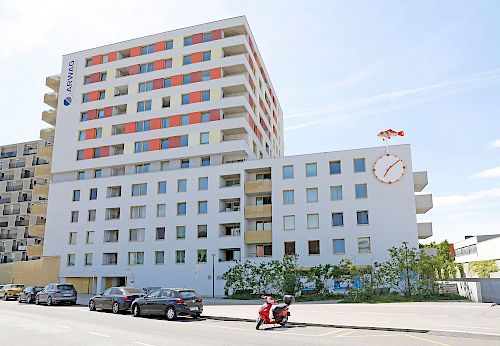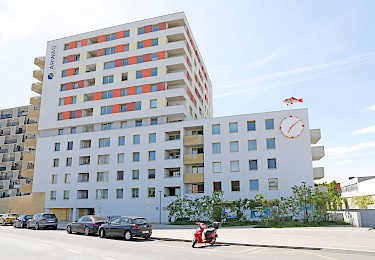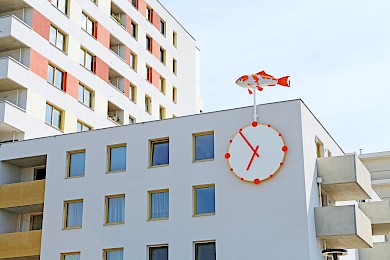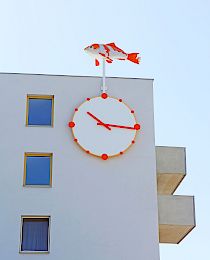What do people today wish for the most? Besides health, probably time. But exactly which time do we want to get hold of? Does time even exist as an objective category? Given all the displays of time in public space—from clocks on church steeples, on the facades of school buildings or railway stations and through to traditional tall free-standing clocks on squares or in parks—there can be no doubt that there is. But is that really so?
Alfredo Barsuglia’s ‘wind clock,’ a two-piece work located on a multistorey residential complex at Erdbergstraße in Vienna’s third district, conveys a distinctively independent notion of time. Firstly, it consists of a large clock face positioned on the upper end of the façade that, despite boasting a diameter of three meters, exudes a somewhat sober if not mundane presence. Instead of numbers, dots mark the hours of the day while the hands are plain bars. The second element of the ‘wind clock’ offers a contrast: the oversized replica of a goldfish which, mounted on a rod, sits enthroned atop the building’s flat roof.
A real eyecatcher, the goldfish recalls the on-roof advertising hotels and restaurants have used since the beginning of commercial modernity to attract attention—company logos or gigantic letters, often lit up to dramatic effect or themselves shining brightly, usually not only highlighting the company or eatery but also giving the building itself an iconic identity.
The two-part work stands out not only when seen from the busy Erdbergstraße, but is visible even further afield, from the other side of the Danube Canal and the Gaswerksteg, a footbridge used by pedestrians and cyclists.
The face of the ‘wind clock’—and this becomes discernible in time—–subverts the system of the conventional displays of time. The clock shows neither the physically defined local time, nor does its hands move in line with the regular strokes of time. The face is not connected to the customary clock mechanism but the goldfish on the roof, which turns with the wind like a weathervane. The tail fin of the fish is a propeller that sets the clock hand in motion, sometimes quicker, sometimes slower, depending on how strong the wind is blowing. The time shown is determined solely by the wind.
Time seems to tick away here uncontrolled and—perhaps even more disconcerting—is uncontrollable. Measuring time in a meaningful way would seem nonsensical here. But maybe there is a way after all? Or maybe there is a way after all? Anyone who moves away from understanding time as quantifiable, no longer as what is no-longer or not-yet, is perhaps able to experience time as a pure present, and thus as pure happiness. And so, we return to the goldfish, in the Far East a symbol of luck and fortune down to the present today. Or to Plato, for whom time is nothing more than the moving image of eternity. (Bernhart Schwenk)
Location
Erdbergstraße 216 A, 1030 Wien
Gallery
Further Information
Alfredo Barsuglia * 1980 in Graz, lives in Vienna (A)
Time Period
From May 7, 2024
Education - Events
Cooperation partner/s





